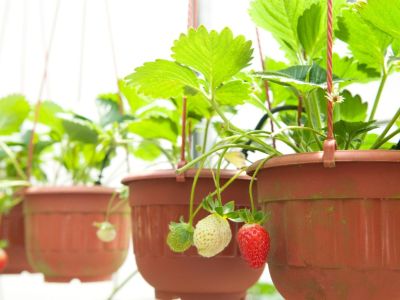Other benefits of a hanging strawberry garden are its resistance to insect infestations and soil borne diseases along with its compact harvest area. If deer or other wildlife tends to nibble on your berry crop before you get a chance at a taste, hanging strawberries may very well be the solution to keeping the tender berries up out of their reach. Hanging strawberry baskets are also easy to move out of the heat or winter cold in order to protect the plant. Follow the information below and say hello to strawberry shortcake!
Growing Strawberries in Hanging Baskets
The key to growing strawberries in hanging baskets is to select plant varieties which produce small berries and are not prone to creating runners or “daughter” plants. June-bearing strawberries are one of the most popular varieties for the home gardener, however, they are not suitable for a hanging strawberry garden due to their propensity of sending out numerous runners and stealing energy that could otherwise be used in fruit production. The best bet for fruit-bearing strawberry baskets are day-neutral strawberry plants. These berry specimens bear fruit at least twice a year, both in the early summer and again in the fall, although with optimal conditions they may produce berries during the entire growing season and, in fact, are often referred to as “ever-bearers.” Some varieties of the Day-Neutrals excellent for use in your hanging strawberry garden are:
‘Tristar’ ‘Tribute’ ‘Mara des Bois’ ‘Evie’ ‘Albion’
Other possibilities for growing strawberries in small spaces are ‘Quinalt’ and ‘Ogallala.’ With dense, compact plants producing small, fragrant, and incredibly sweet berries, another option is the Alpine strawberry, a descendant of the wild strawberry (Fragaria spp). Alpine strawberries thrive in partial shade and, therefore, may be a good option for the gardener with limited sun exposure. They produce fruit from spring through fall. Some examples suitable for growing strawberries in small spaces are:
‘Mignonette’ ‘Rugen Improved’ ‘Yellow Wonder’ (bears yellow berries)
Any of these varieties will do beautifully as hanging strawberry plants. Alpine strawberries may either be found in nurseries or online (as plants or in seed form) wherein a greater variety is available.
Tips on How to Grow Hanging Strawberry Plants
Now that you have selected the correct varietal of suitable hanging strawberry plants, it’s time to choose a container for your hanging strawberry garden. The planter, often a wire basket, should be 12 to 15 inches (31-38 cm.) from top to bottom, deep enough for the roots. With this diameter, there should be ample space for three to five plants. Line the basket with coir or peat moss to aid in water retention or purchase a self-watering basket and fill with soil combined with a good quality fertilizer or compost. Do not use moisture-retaining soils specifically made for use with ornamental plants on these edibles, as they contain hydrogels or chemical polymers. Yuck. Ideally, set the strawberry plants in the spring and, if possible, near spring blooming flowers which are attracting bees, a necessary pollinator for strawberries to set fruit. Position the hanging strawberry plants closer together than you would in the garden.
Care of Hanging Strawberries
Once planted, strawberry baskets should be watered daily and will need regular fertilization (once a month until blooming) due to the rather limited amount of nutrients in the small planter. When watering the growing strawberries in hanging baskets, try not to get the fruit wet so it doesn’t rot, but do not allow the plants to dry out. Feed your hanging strawberry garden at least once a month until blooming, and thereafter every ten days with a controlled release liquid fertilizer that is high in potassium and low in nitrogen. Hanging strawberry plants (except the Alpine varieties) need a good six to eight hours of full sun a day for optimal fruit production. Fruit should be harvested as soon as berries are red, if possible, in dry weather, taking care to leave the green stalk in place once fruit is picked. Remove any runners from the strawberry baskets. Move the hanging strawberry garden to a sheltered area if heat is intense or frost or rainstorms are imminent. Repot hanging strawberries each spring with fresh soil and enjoy the fruits of your labor for years to come — well, for at least three years. Yep, after that it may be time to invest in a new round of plants for your strawberry baskets, but in the meantime, pass the whipped cream.
